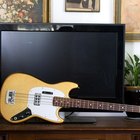
Whether you plan to hold a contest at your school, in your community or during a party, you will need ideas for competition gifts. Choose awards to honor the winners for their hard work and perseverance. Gifts also encourage spectators and aspiring competitors to get involved in future contests. Ask local business owners, friends or family members to donate gifts for your competition.
Holiday Gifts
Hold friendly competitions during Christmas parties. Choose prizes for the winners. Gifts should reflect the holiday's festive spirit. Offer the winner a gift certificate for two tickets to a performance of Charles Dickens' "A Christmas Carol." Present the winners with a less expensive gift, such as a hot chocolate set with marshmallows and peppermint sticks. For a more elaborate gift idea, take the winners on a surprise horse-drawn carriage ride, complete with Santa Claus as a tour guide. Hand out Christmas-themed award certificates.
Athletic Gifts
Choose gifts that promote health and well-being for young athletes competing in a school relay or field day. Give the winners in all the top categories a gift certificate for a free smoothie a month for a year. Offer such prizes as a pair of new running shoes or a gift certificate to a local athletic store. Cut down on your costs while presenting athletes with sought-after prizes--ask local and national businesses to donate gifts to your athletic competition.
Academic Gifts
Hand out awards for such activities as spelling bees and debates. Select awards that honor academic excellence, such as gift certificates to a local book store, a subscription to a literary magazine or a gift card to a local book store's coffee shop. Keep with the book theme. Offer a grand prize that focuses on education, such as a trip to Washington, D.C. Schedule visits to the Library of Congress, the White House, national monuments, art museums and history museums. Give out ribbons or trophies for first, second and third place.
Related Articles

Favor Ideas for a 75th Birthday Party

Activities and Meeting Places in ...

Ideas for Social Committees

What Should I Get My Boyfriend for Our ...

Thank You Ideas for Awana Leaders

How to Form a Pub Crawl to Raise Money

Sober Grad Night Activities

Recognition Theme Ideas

Gift Ideas for a Fifth Grade Girl

Sponsor Thank You Gifts

Church & Family Fun Day Activities

Gifts for a Zumba Instructor

Romantic Things to Do With Your ...

Ideas to Involve Members in the ...

What Do I Get My Boyfriend of Two ...

Types of Extrinsic Motivation

How to Throw an Anime Party

Fun Places to Take Your Boyfriend

Grammy's Themed Party Ideas

How to Prepare a Mother's Day Service
References
Writer Bio
Vera Leigh has worked as a professional freelance writer since 2008. Her work has appeared in "Learn Overseas" and "Grad Source" magazines. In addition, she received an honorable mention in "Newsweek's" My Turn contest. She has written features for nonprofits focused on literacy, education, genomics and health. In her spare time, Leigh puts her English major to use by tutoring in grammar and composition.
Photo Credits
running image by Byron Moore from Fotolia.com